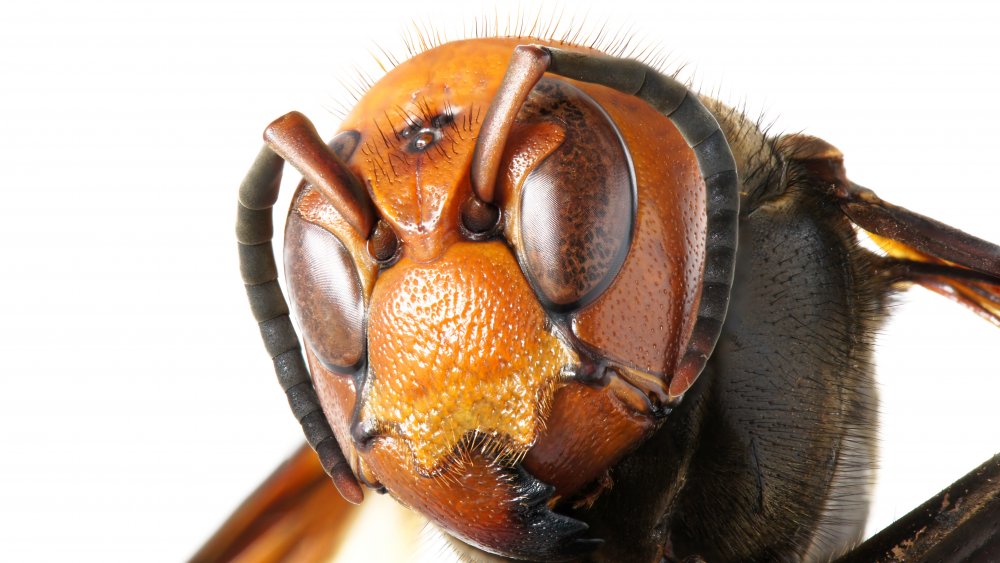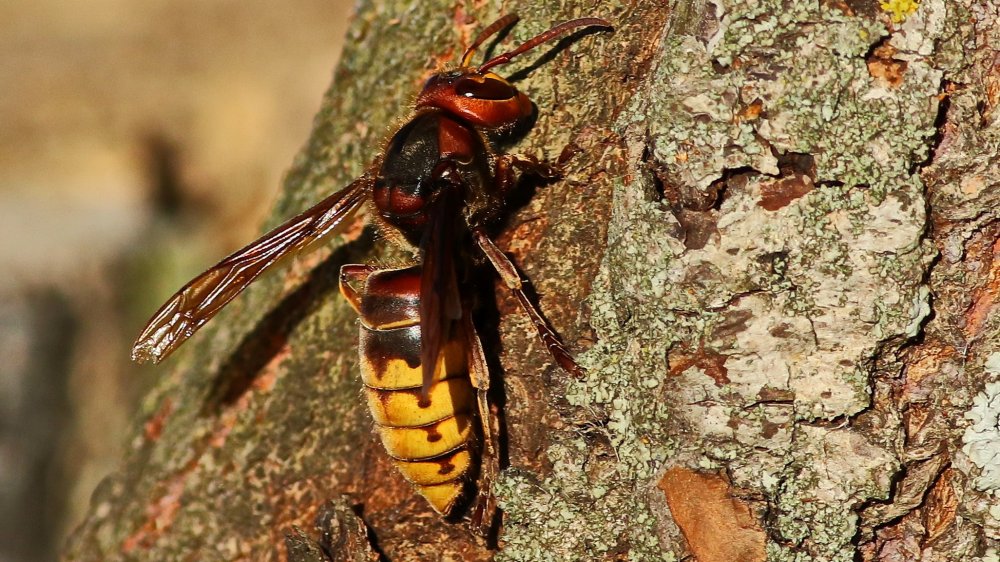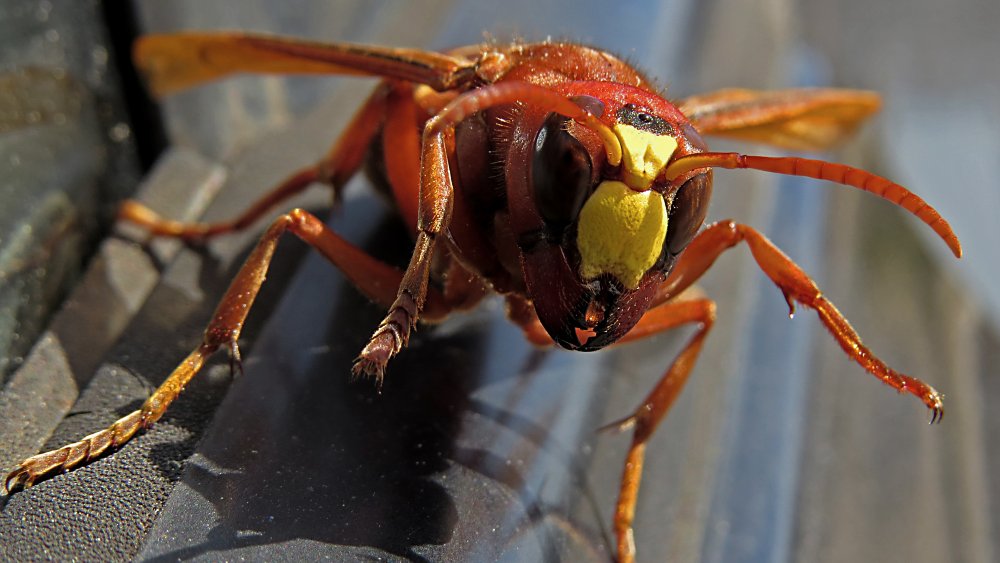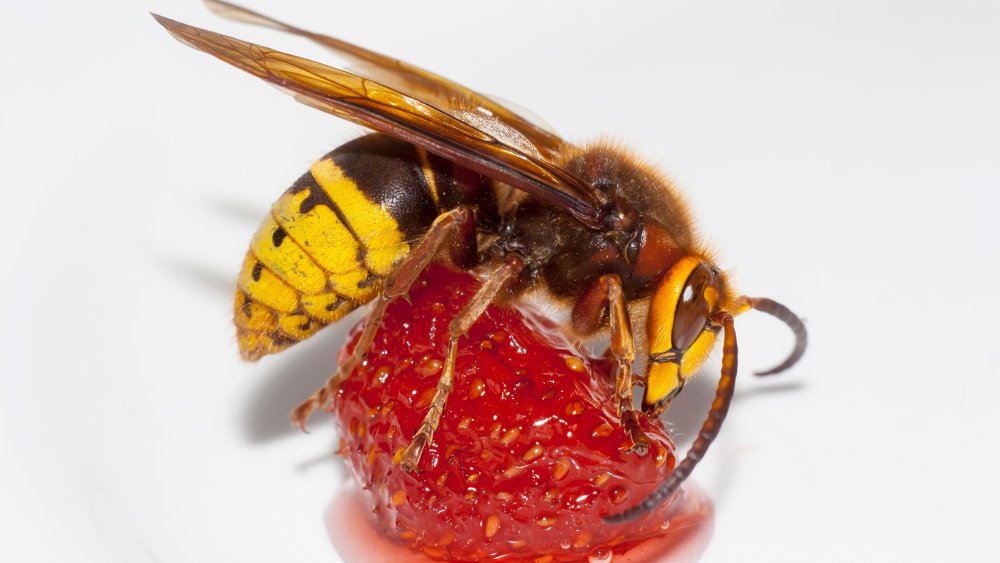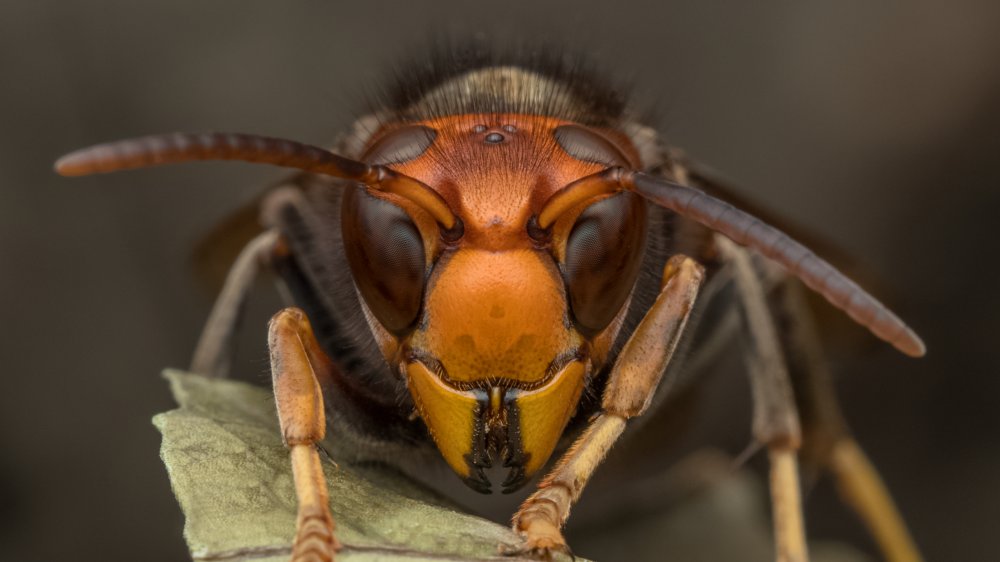Everything You Need To Know About Murder Hornets
You might have noticed the recent "buzz" about a certain, particularly worrying insect that goes by the charming nickname "murder hornet." These unsavory creatures have just been spotted in the U.S. for the first time ever, according to Li Cohen of CBS News. Unfortunately, the nickname is not just a hyperbolic, wacky pro wrestler moniker, either. The hornet we're talking about is Vespa mandarinia, a.k.a. the Asian giant hornet. It's a huge monstrosity that can grow up to two inches long, and bee breeder Susan Cobey of Washington State University's Department of Entomology describes them as "like something out of a monster cartoon with this huge yellow-orange face." Incidentally, here's a good rule of thumb for life: When experts start comparing insects to fictional monsters, it's probably a good time to get at least mildly worried.
There have been four verified sightings of the Asian giant hornet in Washington state, and a further two in Canada's British Columbia. Luckily, Rian Wojahn of Washington State Department of Agriculture has told Time that officials are addressing the situation with "an aggressive outreach and trapping campaign," so hopefully, our near future doesn't include too many murder hornet swarms. Still, it's probably a good idea to read up on these things, just in case. Here's everything you need to know about murder hornets.
Their sting is painful and potentially lethal
If you see an Asian giant hornet, we have good news and bad news. The good news is that they don't really actively target humans. However, the bad news is that if they do decide to sting you, you're in a world of pain. Even beekeeper suits can't stop their stings, which are Bad with a capital B. Conrad Bérubé, a beekeeper who was stung around seven times while getting rid of a nest, describes the feeling as "the most painful sting he's ever experienced," writes Mike Baker of the New York Times. The sting is said to feel a bit like hot metal being injected in your body.
Oh, and of course the murder hornet's sting is potentially lethal. Its venom includes a heaping helping of neurotoxins, and if enough of the stuff enters your body, it can kill you. Sure, one sting may not be enough, but enough of them might — and these being hornets, it's worth pointing out that they can sting multiple times. This is not a theoretical scenario, either. Reportedly, murder hornets kill as many as 50 people in Japan every year.
More like 'massacre' hornets
Sure, the murder hornets are no picnic for humans, but for honey bees, they're terror incarnate. The Asian giant hornet neither uses nor needs its venomous stinger to deal with bees. For them, it sports a pair of mandibles that look a whole lot like shark fins that are equipped with spikes.
When Asian giant hornets enter a bee hive, they also enter a horror movie villain state known as "slaughter phase," where they start using said mandibles to decapitate the poor bees. All the poor bees, at a truly alarming rate. It takes just a few of the murder hornets to completely annihilate a honey bee hive within a few hours. After the awful deed is done and the murder hornets have overtaken the hive, they're somehow still not done. Instead, they start happily collecting the bees' thoraxes and flying them off as a feast for their young.
What can we do about the murder hornets?
Now that we know murder hornets are awful for humans and bees alike, what can we — or, for that matter, the bees — do about them? Quite a lot, actually. As we mentioned earlier, the WSDA is keeping tabs on the situation, trapping and tracking as sightings emerge. For this purpose, experts urge everyone who sees Asian giant hornets around to steer clear of them, and to be sure to report their sightings instead of attempting to get rid of the invasive pest by themselves. This is a fight best left to the professionals.
As for bees, it turns out some of them have already figured out the way to deal with murder hornets. As Mike Baker of the New York Times tells us, some bees have figured out that they can't match murder hornets' size and strength, so they employ a sneaky tactic where hundreds of bees swarm the hornet, which is trapped inside a large bee-ball. The bees then basically cook the hornet alive by vibrating in unison, which raises the ball's temperature to over 115 degrees — which the bees can survive, but the hornet can't. The tactic takes up to an hour, but it works. Unfortunately, at the moment, only Japanese honey bees seem to know the trick, having developed it over many generations. Here's hoping that Western bees don't have to learn it the hard way, as well.
Swallow your fear
Of course, there's always a way to take murder hornets and make murder hornet lemonade. In this case, we could take after Japan and eat them. That's right — the New York Times reports that the more adventurous palates in the Land of the Rising Sun enjoy them as a "pleasant snack and an invigorating ingredient in drinks." Young or old, there's a murder wasp flavor for everybody.
Some enjoy the grubs "preserved in jars, pan-fried or steamed with rice to make a savory dish called hebo-gohan." Others like to face their fears head on, enjoying fried or skewered adult hornets ... even the stinger. Supposedly they leave a "warming, tingling sensation", when eaten, but that may just be the pleasant, calming feeling of slipping into the afterlife.
You could always drink your hornet, as some enjoy the extra kick they provide to alcohol. Live specimens are sometimes drowned in shochu, a clear, distilled beverage somewhere in between liquor and rice wine in terms of strength. While in their death throes, "the insects release their venom into the liquid, and it is stored until it turns a dark shade of amber."
